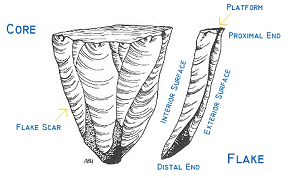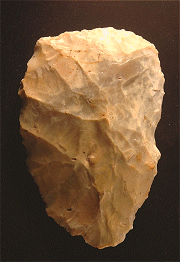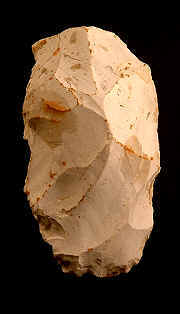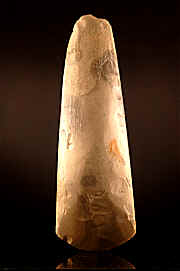How
our ancestors made Stone Age tools
- Early in human evolution people discovered that
stone can be used to make tools. They found that flint, which is
close behind diamond in hardness, fractures easily to give razor sharp edges.
In the Palaeolithic
period, or early stone age, humans developed great skill at fashioning beautiful tools
such as the hand axes shown right. People were nomadic hunter-gatherers
who probably made tools on the spot to skin and butcher
large game.
-
- Later, in the Mesolithic or middle stone
age, still nomadic, people developed skills at making flake tools including tiny
Microliths that could be mounted in a wooden shaft to make arrows or
spears and the first purpose-designed carpentry tools like the Tranchet
adze (right).
-
- In the Neolithic or new stone age, people began
to live in agricultural settlements. They had time to make
intricately flaked
tools such as scythes and polished axes (Below right).
The processes they used left distinctive
marks on the tools they made. If you get a suitable large piece of flint
(called a core) and strike it near the edge with a round
pebble, called a hammer stone, you will break off a flint flake. In the
palaeolithic period this technique was used to chip flakes
away, leaving the core as the tool. In the Mesolithic, this
process was commonly reversed - large flakes were chipped
away to make scrapers and cutting tools and the core was
discarded.
-
- To get decent sized, usable
flakes, you need to prepare the striking surface - called the platform -
so it is
flat and at less than 90 degrees to the front face of the core.
Bulb of percussion and strike point
When a toolmaker (known as the flint knapper) strikes the platform of his/her core with
a hammer stone near the edge, a flake breaks away, leaving a distinctive mark of the
impact. This is a sharp lump that juts out just below the
point of impact and often a bulge that tapers away down the length of
the flake
in the direction in which it was struck. These are the striking point
and the 'positive bulb
of percussion'. There is a corresponding concave or negative bulb left
behind on the flint core from which the flake was struck.
If the toolmaker then strikes
a second flake from the same place, but a
few millimetres further back from the platform edge, the thin flake that
comes away will have a positive bulb of percussion on the inside surface
(front) and a
negative bulb of percussion on the outside or back, giving a very distinctive
curve to the side view or section through the flake.
 
Sometimes, the toolmaker will prepare his or her target flake, taking
off some long thin preparatory flakes, creating shallow facets on the
core.
What were flint tools used for?
It's natural to wonder what our
ancestors used their tools for and it's tempting to
imagine all kinds of purposes, but the reality is that we
can never know exactly what use they were put to. For example, it used to be
thought that palaeolithic axes were hafted in wooden
handles. Later they were described as 'hand axes' in
recognition of the fact that no evidence exists for
hafting. Today they are described merely as 'bifaces'
in recognition that they may not even have been used as
axes at all. It has even been seriously suggested that
beautifully crafted early Palaeolithic bifaces may have
been marriage offerings!
All we can say for certain is
that our ancestors needed to skin and butcher the game
they killed, and they needed to process the hides by
scraping to make them suitable for clothing and shelter.
At least some of their tools must have been made for this
purpose. They also needed to make fire and, again,
some flints must have been intended for this end.
To what extent nomadic people
carried tools about with them ('curated' them) and to what
extent they made them on the spot is not known with any
certainty. Tools are sometimes found made from distinctive
local flint, many miles from their point of origin, but
this could equally well be evidence for curating tools or
of trade in tools or raw flint.
In this sea of uncertainty there
are a few knowns. Side and end scrapers were almost
certainly intended for processing skins. The
tranchet adze, which could be re-sharpened by taking a
flake across its working tip, was almost certainly used
for carpentry and its introduction in the Mesolithic
coincides with the building of timber fishing platforms,
remains of some of which have been found. Making
spear shafts and arrows must have required suitable
spokeshaves or notched pieces. Microliths
have been found embedded in wooden handles preserved in
peat bogs. The rest is, at present, speculation.
|
|

Palaeolithic biface hand axe
Click to enlarge

Late palaeolithic Neanderthal biface hand axe
Click to enlarge

Mesolithic tranchet adze - a purpose-made carpentry tool
Click to enlarge

Neolithic polished flint hand axe
Click to enlarge
|